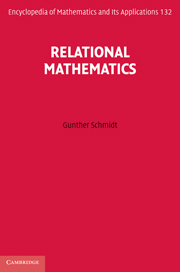Book contents
- Frontmatter
- Contents
- Notes on illustrations
- Preface
- 1 Introduction
- PART I REPRESENTATIONS OF RELATIONS
- PART II OPERATIONS AND CONSTRUCTIONS
- PART III ALGEBRA
- 8 Relation algebra
- 9 Orders and lattices
- 10 Rectangles, fringes, inverses
- 11 Concept analysis
- PART IV APPLICATIONS
- PART V ADVANCED TOPICS
- Appendix A Notation
- Appendix B Proofs postponed from Part II
- Appendix C Algebraic visualization
- Appendix D Historical annotations
- References
- Symbols
- Index
9 - Orders and lattices
from PART III - ALGEBRA
Published online by Cambridge University Press: 05 May 2013
- Frontmatter
- Contents
- Notes on illustrations
- Preface
- 1 Introduction
- PART I REPRESENTATIONS OF RELATIONS
- PART II OPERATIONS AND CONSTRUCTIONS
- PART III ALGEBRA
- 8 Relation algebra
- 9 Orders and lattices
- 10 Rectangles, fringes, inverses
- 11 Concept analysis
- PART IV APPLICATIONS
- PART V ADVANCED TOPICS
- Appendix A Notation
- Appendix B Proofs postponed from Part II
- Appendix C Algebraic visualization
- Appendix D Historical annotations
- References
- Symbols
- Index
Summary
Lattices penetrate all our life. Early in school we learn about divisibility and look for the greatest common divisor as well as for the least common multiple. Later we learn about Boolean lattices and use union and intersection “∪,∩” for sets as well as disjunction and conjunction “⋁,⋀” for predicates. Concept lattices give us orientation in all our techniques of discourse in everyday life - usually without coming to our attention. Nevertheless, lattices completely dominate our imagination. Mincut lattices originate from flow optimization, assignment problems, and further optimization tasks. It is well known that an ordering can always be embedded into a complete lattice. Several embedding constructions are conceivable: examples are cut completion and ideal completion.
We introduce all this step by step, concentrating first on order-theoretic functionals. Then we give several examples determining the maximal, minimal, greatest, and least elements of subsets. Thus we learn to work with orderings and compute with them.
Maxima and minima
Whenever an ordering is presented, one will be interested in finding maximal and minimal elements of subsets. Of course, we do not think of linear orderings only. It is a pity that many people – even educated people – colloquially identify the maximal element with the greatest. What makes this even worse is that the two concepts often indeed coincide. However, the definitions and meanings become different in nature as soon as orderings are not just finite and linear.
- Type
- Chapter
- Information
- Relational Mathematics , pp. 183 - 199Publisher: Cambridge University PressPrint publication year: 2010
- 1
- Cited by



